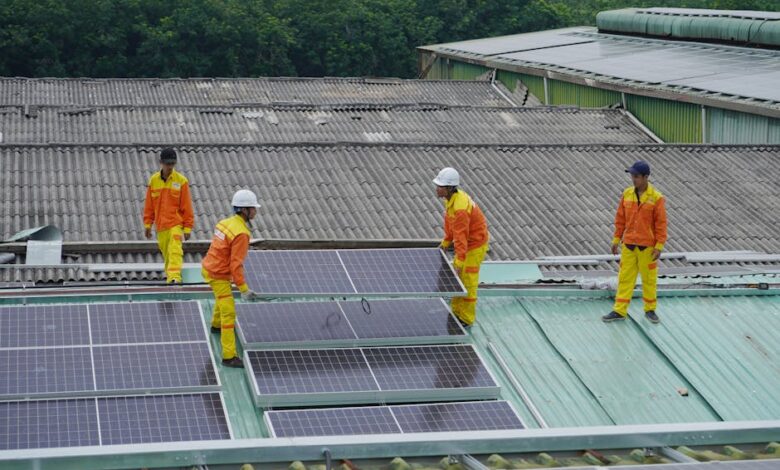Towards a Sustainable Future: Navigating the Renewable Energy Revolution and Its Challenges

As the world grapples with the urgent need for sustainable solutions to combat climate change, the rise of renewable energy sources—particularly solar, wind, and hydrogen—has emerged as a beacon of hope. This shift towards clean energy is not merely a trend; it represents a fundamental transformation in how we produce and consume power. Governments across the globe are stepping up, implementing initiatives and incentives designed to accelerate this transition and reduce reliance on fossil fuels. However, the journey to a sustainable energy future is fraught with challenges, including the critical issue of energy storage, which is essential for balancing supply and demand in renewable systems.
In this article, we will explore the multifaceted landscape of the renewable energy revolution, highlighting the role of innovative technologies, the potential of nuclear energy in a low-carbon world, and the adaptability of traditional oil and gas companies in this new era. We will also discuss the significant impact of electric vehicles on reducing fossil fuel dependency and the economic repercussions of fluctuating energy prices. Finally, we will examine cutting-edge advancements in energy efficiency that promise not only to drive down costs but also to pave the way for a more sustainable future. Join us as we delve into these pressing topics and envision a world powered by clean, renewable energy.
- 1. **Powering the Future: The Surge of Solar, Wind, and Hydrogen Energy**
- 2. **Government Initiatives and Incentives: Catalyzing the Clean Energy Transition**
- 3. **Navigating Challenges: Energy Storage Solutions for a Renewable Tomorrow**
1. **Powering the Future: The Surge of Solar, Wind, and Hydrogen Energy**
The global shift towards renewable energy sources has gained unprecedented momentum in recent years, with solar, wind, and hydrogen power leading the charge. These clean energy technologies are not only pivotal in mitigating climate change but also in reshaping the energy landscape to create a sustainable future.
Solar energy has emerged as one of the most accessible and rapidly growing sources of renewable energy. Advances in photovoltaic technology have significantly reduced the cost of solar panels, making them more affordable for both residential and commercial applications. Governments worldwide are incentivizing solar adoption through tax credits, rebates, and net metering policies, encouraging individuals and businesses to invest in solar installations. As a result, solar power capacity has skyrocketed, contributing a substantial share of electricity generation in many countries.
Wind energy, too, has seen remarkable growth, driven by technological advancements and economies of scale. The development of larger, more efficient turbines has increased the viability of wind farms, both onshore and offshore. Governments are supporting this expansion through favorable regulatory frameworks and financial incentives, such as power purchase agreements and feed-in tariffs. Wind energy is now a cornerstone of many nations' energy strategies, significantly diversifying the energy mix and reducing reliance on fossil fuels.
Hydrogen energy is gaining attention as a versatile energy carrier that can complement solar and wind power. By using excess renewable energy for electrolysis, hydrogen can be produced and stored for later use, addressing the intermittent nature of solar and wind generation. Governments are investing in hydrogen infrastructure and research to unlock its potential as a clean fuel for transportation, industry, and energy storage. Initiatives aimed at developing green hydrogen projects are emerging globally, signaling a commitment to integrating hydrogen into the clean energy transition.
The convergence of these renewable technologies marks a transformative period in energy production and consumption. As countries commit to ambitious climate goals, the surge of solar, wind, and hydrogen energy will play a crucial role in driving the transition to a low-carbon economy, ensuring a sustainable and resilient energy future.
2. **Government Initiatives and Incentives: Catalyzing the Clean Energy Transition**
Governments around the world are playing a pivotal role in catalyzing the transition to clean energy through a range of initiatives and incentives designed to promote renewable energy sources such as solar, wind, and hydrogen power. These measures aim to reduce greenhouse gas emissions, enhance energy security, and stimulate economic growth.
One of the most common approaches is the implementation of financial incentives, including tax credits, subsidies, and grants for renewable energy projects. For instance, the Investment Tax Credit (ITC) in the United States allows businesses and homeowners to deduct a significant percentage of the installation costs of solar energy systems from their federal taxes. Similarly, feed-in tariffs and power purchase agreements in various countries guarantee fixed payments for energy generated from renewable sources, providing a stable revenue stream for developers.
In addition to financial incentives, governments are increasingly setting ambitious renewable energy targets and mandates. Many countries have established policies to achieve specific renewable energy penetration levels by certain dates, creating a clear regulatory framework that encourages investment. For example, the European Union has set a goal for at least 32% of its energy to come from renewable sources by 2030, pushing member states to develop their own national plans to meet this target.
Moreover, governments are investing in research and development to advance renewable energy technologies and improve energy efficiency. By funding innovation, they aim to lower costs and enhance the competitiveness of clean energy solutions. Collaboration with the private sector, universities, and research institutions is essential in driving technological breakthroughs that can address current limitations in renewable energy systems.
Public awareness campaigns and educational initiatives are also critical components of government strategies to promote clean energy. By informing citizens about the benefits of renewable energy and energy efficiency, governments can foster a culture of sustainability and encourage individuals and businesses to adopt cleaner practices.
Ultimately, these government initiatives and incentives are crucial for accelerating the clean energy transition. By providing financial support, establishing regulatory frameworks, investing in innovation, and raising public awareness, governments can create an environment conducive to the growth of renewable energy, helping to mitigate climate change and build a sustainable future.
3. **Navigating Challenges: Energy Storage Solutions for a Renewable Tomorrow**
Energy storage solutions are critical for addressing the intermittent nature of renewable energy sources such as solar and wind. As these energy sources generate power only when conditions are favorable—sunlight during the day and wind during certain weather patterns—efficient storage systems are essential for ensuring a stable and reliable energy supply. The challenge lies in developing technologies that can store large amounts of energy cost-effectively and for extended periods.
Currently, several storage technologies are being explored and implemented. Lithium-ion batteries have gained prominence due to their widespread use in electric vehicles and portable electronics. They offer rapid discharge and recharge capabilities, making them suitable for balancing supply and demand on the grid. However, challenges such as resource scarcity, recycling issues, and high costs limit their scalability for large-scale energy storage.
Another promising solution is pumped hydro storage, which leverages gravity to store energy by pumping water uphill to a reservoir during periods of low demand and releasing it during peak demand. While this technology has been effective for decades, its geographic limitations and environmental impacts can pose challenges.
Emerging technologies, such as flow batteries and solid-state batteries, show potential for longer-duration storage. Flow batteries utilize liquid electrolytes, allowing for easy scaling and longer life cycles, while solid-state batteries promise enhanced safety and energy density. Additionally, innovations in hydrogen storage, where excess renewable energy is used to produce hydrogen through electrolysis, provide a versatile option for long-term energy storage and transportation.
As the world transitions to a renewable energy future, addressing the challenges of energy storage will be crucial. Investments in research and development, along with supportive policies, can accelerate the deployment of diverse storage solutions, ultimately facilitating a more resilient and sustainable energy system. By overcoming these obstacles, we can harness the full potential of renewable energy, ensuring a reliable and clean energy supply for generations to come.
In conclusion, the rise of renewable energy marks a pivotal shift in our approach to meeting global energy demands while mitigating climate change. Solar, wind, and hydrogen power are leading the charge, supported by robust government incentives aimed at fostering a sustainable future. However, the transition is not without its challenges, particularly in energy storage, which remains a critical barrier to fully harnessing these resources.
As we look ahead, the role of nuclear energy in a low-carbon world may become increasingly significant, offering a reliable complement to intermittent renewable sources. Meanwhile, traditional oil and gas companies are adapting by investing in cleaner technologies and diversifying their portfolios, reflecting a broader industry shift toward sustainability. The proliferation of electric vehicles further underscores this transition, reducing our dependency on fossil fuels and reshaping transportation dynamics.
Moreover, the economic implications of energy price fluctuations demand attention, as they can influence everything from consumer behavior to investment strategies. Innovations in energy efficiency present exciting opportunities for cost savings and resource optimization, making them integral to the energy landscape of tomorrow.
As we navigate this evolving terrain, it is clear that a collaborative effort among governments, industries, and consumers is essential to realize a cleaner, more resilient energy future. The path may be fraught with challenges, but the collective commitment to sustainability and innovation promises a brighter, greener world for generations to come.





